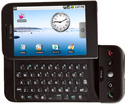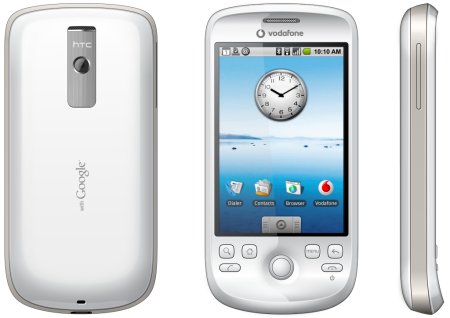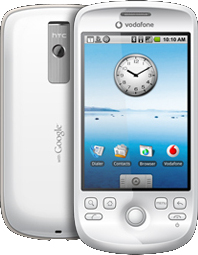Android phone to hit Europe in spring
Feb 17, 2009 — by Eric Brown — from the LinuxDevices Archive — 2 views Vodafone and HTC announced the latter's second-generation, all-touchscreen Android phone. Scheduled to ship to Vodafone customers in Europe this spring, the Android Magic offers HDSPA 3G connectivity, and a slimer profile than the G1, lacking the earlier HTC Android phone's slide-out keyboard.
Vodafone and HTC announced the latter's second-generation, all-touchscreen Android phone. Scheduled to ship to Vodafone customers in Europe this spring, the Android Magic offers HDSPA 3G connectivity, and a slimer profile than the G1, lacking the earlier HTC Android phone's slide-out keyboard.
(Click for larger view of the HTC Magic)
The recently rumored “G2” phone was unveiled as the HTC Magic at the Mobile World Congress in Barcelona today, just when it seemed that nobody would be showing a major Android phone at the show. (Huawei announced an Android phone, but had few details.)
 HTC G1 (Click for details) |
Whereas the HTC G1 (pictured at right) was carried exclusively by T-Mobile, and available both in the U.S. and Europe when it started shipping in October, this time it's Vodafone's turn.
Vodafone is offering the HTC Magic initially only to Vodafone customers, in the UK and Spain, followed by Germany and France, all in exclusive deployments. It will then be offered non-exclusively in Italy, with more countries to follow, says Vodafone. However, the Magic's current cellular modem reportedly does not support the frequency bands used by North American HDSPA providers, limiting users here to 2.75G Edge data connections at best.
Like the iPhone and other recent smartphones, the Magic depends solely on its touchscreen and a few buttons, with no keyboard included. Like the G1, it is based on the ARM-based Qualcomm MSM7201a processor, clocked similarly to 528MHz, with the same complement of 192MB RAM. However, it offers twice the ROM of the G1, for a total of 512MB. A microSD card slot is available, supporting up to 8GB of flash, but there was no mention of the standard 1GB microSD card that is available for the G1.

HTC Magic
(Click to enlarge)
Despite the new emphasis on the touchscreen, the display appears to be the same 3.2-inch QVGA touchscreen as before. To make up for the lack of the keyboard, the Magic offers a larger trackball and additional navigational buttons. The Magic provides features similar to the G1's, including USB-ETX, WiFi, and Bluetooth radios, as well as a 3.2Mpix camera, GPS device, digital compass, and accelerometers.
3G radios rev to 7.2Mbps
The key new addition to the Magic is the new HSDPA/WCDMA 3G support. The phone is said to be capable of up to 2Mbps uplink speeds and 7.2Mbps downlink performance. Two other new features include full Bluetooth support, which was lacking in the initial release of Android, and video capture support, say the companies.
As with T-Mobile, Vodafone customers gain access to the Android Market, and its growing list of Android apps and games. The HTC Magic comes standard with email options such as Google Mail, POP3, and IMAP, as well as Google Talk for instant messaging. It also features Google applications, including Google Maps and Google Search, plus a YouTube player. All this is available with the usual touch interface, but not the iPhone like “multi-touch” support, which is expected in a future release of Android.
 HTC Magic: Look, Ma no keyboard |
Specifications listed for the HTC Magic from Vodafone include:
- Processor — Qualcomm MSM7201a 528MHz
- Memory — 192MB RAM; 512MB ROM
- Memory expansion — microSD memory card slot (SD 2.0 compatible)
- Display — 3.2-inch TFT-LCD flat touch-sensitive screen; QVGA (320×480) resolution
- 2G network — Quad-band GSM/GPRS/EDGE (850/900/1800/1900 MHz)
- 3G network — HSDPA/WCDMA (900/2100 MHz); up to 2Mbps uplink and 7.2Mbps downlink
- WiFi — 802.11 b/g
- Bluetooth - Bluetooth 2.0 with Enhanced Data Rate
- USB — 11-pin mini-USB 2.0 and audio jack in one
- GPS — internal GPS antenna
- Camera — 3.2Mpix color camera with autofocus
- Other features — G-sensor (accelerometer); digital compass
- Controls — trackball with Enter button
- Audio formats — AAC, AAC+, AMR-NB, MP3, WMA, WAV, AAC-LC, MIDI, OGG
- Video formats — MP4, 3GP
- Battery — rechargeable Lithium-ion 1340mAh; up to 400 minutes (WCDMA) or 450 minutes (GSM) talk time; up to 660 hours (WCDMA) or 420 hours (GSM) standby
- Power — AC adapter voltage range/frequency of 100 ~ 240V AC, 47/63 Hz; DC output 5V and 1A Special
- Dimensions — 4.5 x 2.2 x 0.5 inches (113 x 55 x 13.65mm)
- Weight — 4.2 oz (118.5 gr) with battery
- Operating system — Android (Linux/Java)
Stated Patrick Chomet, Global Director of Terminals, Vodafone Group, “Delivering an unbeatable mobile internet experience for our customers is a priority for Vodafone. We have worked very closely with HTC to bring this cool new phone to the market.”
Stated Peter Chou, president and CEO, HTC Corp., “The HTC Magic embodies the compact style and sophistication for which HTC has come to be known, with the powerful and intuitive internet experience for which the Android platform was designed.”
Stated Andy Rubin, Senior Director of Mobile Platforms at Google, “Vodafone is opening up the mobile web for consumers across Europe and giving more third-party developers a platform on which they can build the next wave of killer applications.”
Vodafone, which claims to be the top global carrier, based on sales, joined the Open Handset Alliance (OHA), Android's governing body, last Fall. The giant wireless carrier also recently announced it would ship a LiMo-based phone this year.
Availability
When Vodafone ships the HTC Magic this spring, it promises “full details of availability and pricing” at its Vodafone site. The phone will be available in white in the UK, Spain, and France, but only in black in Germany, and in both colors in Italy, says Vodafone. Meanwhile, more information on the phone may be found at this HTC page.
This article was originally published on LinuxDevices.com and has been donated to the open source community by QuinStreet Inc. Please visit LinuxToday.com for up-to-date news and articles about Linux and open source.